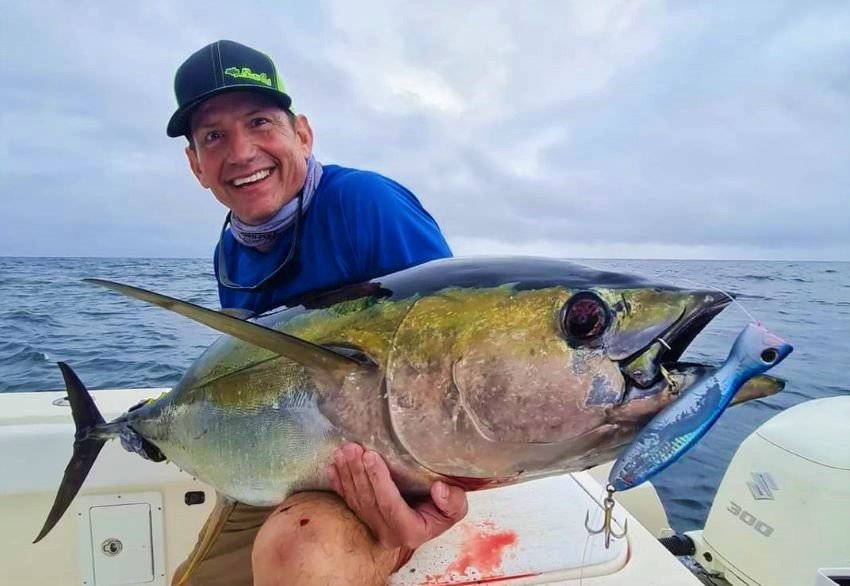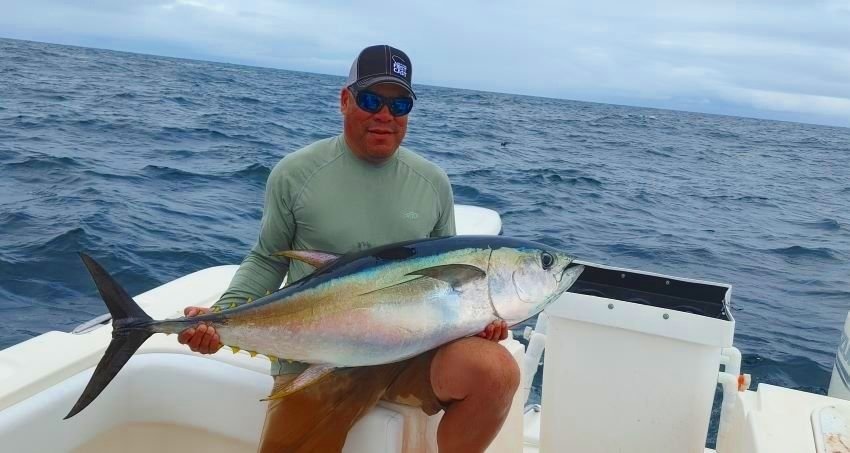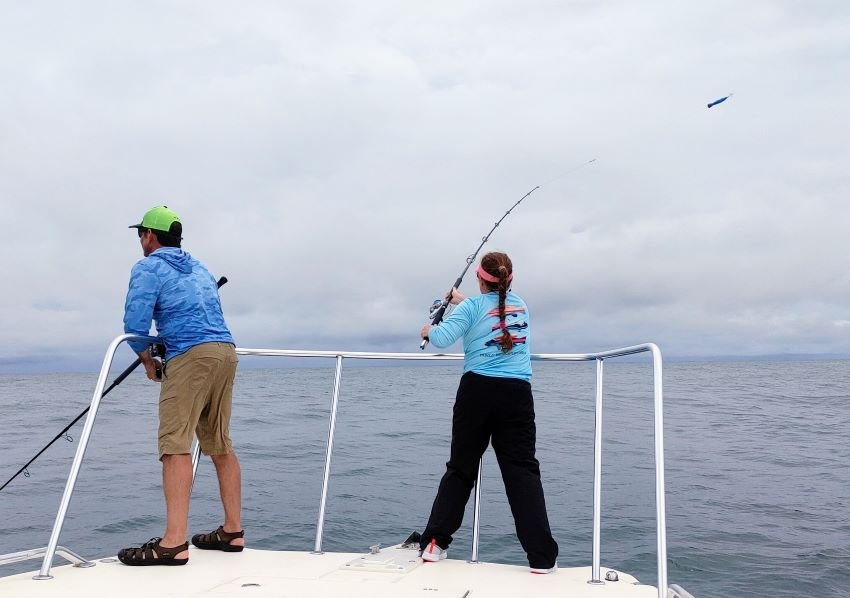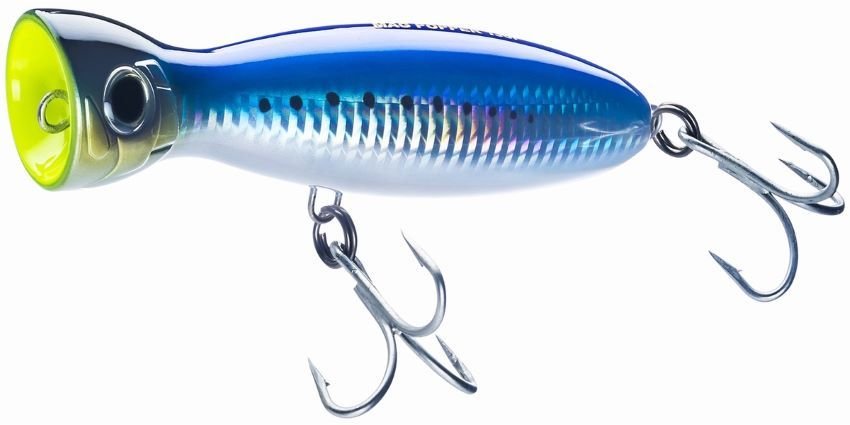Tips for Your First Tuna Popping Trip to Panama
We first became intrigued about fishing in Panama when my friend Elliott Stark described to me the process of popping for tuna, and then sent a few videos. I’m a topwater addict, whether it’s chasing smallmouths up north or peacock bass south of the equator, but I’d never seen anything like acres of herding dolphins, diving birds, and rampaging yellowfin tuna converging in a tornado of chaos. The reality lived up to the hype, too. On our first trip to Sport Fish Panama Island Lodge in April of 2021 we were able to hook up and land some finned freaks of nature on our first stop. With three trips under our belt now, I still get as excited as when I saw that first boil and then heard the drag sing.
Seriously, if you’re a bass angler, you owe it to yourself to check this out, and if you thought that peacock bass provided the ultimate surface thrill, you’re in for a rude awakening. I still love our Amazon trips, but from the perspective of pure power and fishy violence, the two are not directly comparable.
So once you’ve decided that this trip is for you, I have some thoughts on how to make sure that you maximize the experience. I’m certainly far from being an expert, but if you follow these basic guidelines it should improve your success, ensure safety, and produce some indelible memories (plus sashimi):
Safety First – You are dealing with bucking waves, moving boats, heavy lures and sharp hooks. You do not want to take a topwater to the noggin, fall out of the boat, or otherwise hurt yourself or your friends. Any of those can spell a quick end to a bucket list trip. When in doubt, exercise max caution.
Set Up a System – When you rush to the tuna boil, you’ll typically need to fire in a cast as quickly as possible while the fish are frenzied. That’ll require climbing to the front deck, carrying your rod, often while the boat is still sliding in to place. If there are three or four of you popping on the boat, figure out ahead of time who will fish from which position. You might even want to take turns, handing the rod to the designated caster so that he or she can grab a prime position quickly and safely.
Get Used to the Tackle – If you’re a bass angler like us, you’re probably not used to heaving a giant spinning rod. It’s not hard to do, but it’s going to take a different stance and different (two-handed) grip than you use when flicking a shakey head or dropshot. Start with shorter casts, getting used to the heavy braid and the thicker grip.
Retain Your Grip – Between tuna slime, saltwater, rain and excitement, it’s easy to try to make a bomb cast as far as you can only to see the rod and reel fly into the drink. Since these combos may easily cost over a thousand bucks, that’s something you’ll want to avoid. We had one angler do that on this last trip. Fortunately for all of us, the bail was open, the popper floated up, and after winding in 300 yards of braid we got the whole deal back.
Account for Leader Length – In our experience, most of the time there’s a 3- or 4-foot leader of heavy fluorocarbon attached to the braid mainline. Usually it’s a loop attached to a snap, although on a few occasions we’ve seen the line joined with an FG Knot. When there’s a leader, you need to be extra-careful with your backcast, ensuring that the lure or rod tip doesn’t hit an outrigger, rod rack, radar unit or another angler.
Time the Waves – If the sea is anything but dead flat, your casts will be affected (lengthened or shortened) by the motion of the ocean. Be cognizant of when you’ll be rising and when you’ll be falling so that you can put the bait where you want it.
Utilize the Rail – If the boat has a rail on the front and you’ll be casting from that position, use it to your advantage. Lean into it, brace yourself, and take some of the strain off of your body.
Good Shoes Matter – Even on a non-skid deck, it can get slippery or even treacherous when you’re in the heat of the moment, and an unplanned and untimely slip can result in a concussion, broken bones or at the very least a missed opportunity. Get good boat shoes and wear them. This will also prevent other injuries and problems as you step around the boat, knocking into cleats and other unexpected parts.
Bend at the Knees – While you’re rushing to the next spot, making a cast or fighting a fish, nearly all of your energy will be focused on that task. Invariably, a swell or wake comes in at the wrong time and you’ll be out of position. By keeping your knees bent you’re ready to absorb those unexpected position changes and you can keep firing without missing a beat or hurting yourself.
Mix Up Retrieves – Unlike bass fishing, I haven’t found a time when the tuna would only eat the poppers when presented in a certain cadence. Nevertheless, try hard pops with maximum splashes, and then mix in just a straight retrieve with more of a chugging action. No matter what, keep it fast – in my experience you cannot move your popper too rapidly for a yellowfin.
Adjust Your Rod Angle – When you throw your Rico for largemouths, you’re likely keeping your rod at one angle because the waves don’t make a difference. With tuna, however, rollers might affect your ability to keep your lure situated on the surface and chugging along. You can start with downward pulls, but if the wave action boogers that up, try putting your rod tip up and moving it from that angle.
Can’t Stop, Don’t Stop – No matter what, when you see that chasing flash, or a Volkswagen-sized explosion, don’t stop the lure. They want it presented fast, and the fleeing action is more likely to produce a hookup.
Fight Fish from Below – If you think you’re going to have trouble subduing the fish, get off the front deck, so you can chase the tuna around the boat safely and confidently. Don’t hesitate to ask for a fighting belt or a Cush-It to make the fight more comfortable, too.
Use Your Energy Wisely – This is the most exciting fishing I’ve ever done, but it can also be mentally and physically debilitating. After you battle a 100-pound tuna you may need a break. After chasing the school for miles, your body may likewise be bruised and/or exhausted. Take a rest, eat something, drink water, and pick your battles and timing carefully. Sometimes a tuna can be more than you bargained for.
Again, I’m not an expert, but I’ve quickly become addicted to this style of fishing and cannot wait to return to Panama. If you’d like to join us, or go with a group of your own, email Hanna and she’ll get you all of the information you need.








